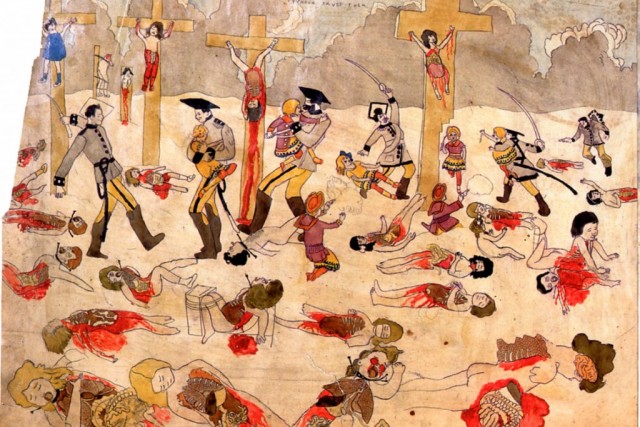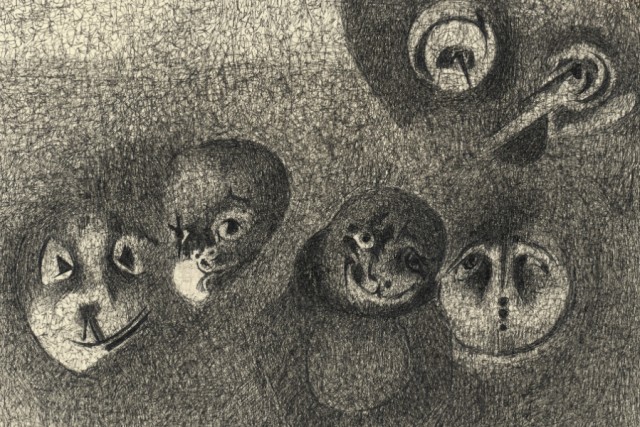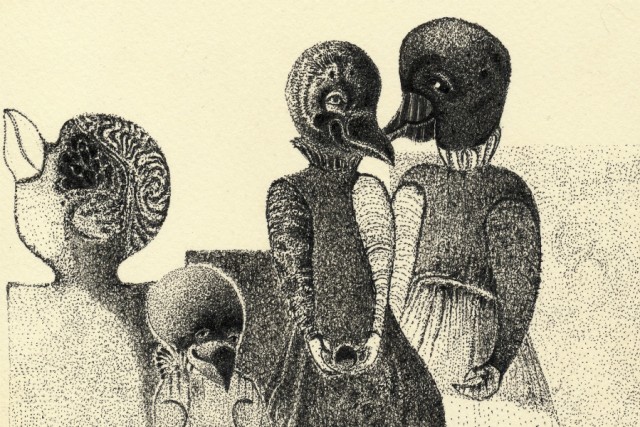Artist of the Month: Penny Davenport
Artist of the Month Penny Davenport talks outsider art, the violence of Goya, and why her drawings aren’t at all that scary…
Textured, scratchy, atmospheric: Penny Davenport’s claustrophobic depictions of creatures and dark spaces seem to hit a nerve with us. It’s like a dream, or nightmare, revisited: animals morph into humans; mist-covered landscapes roll and drop into the distance; goofy looking things with black, wet eyes dance on the spot, or simply stand there, looming into view. The most uncomfortable part is imagining that maybe they’ve been there all along, lurking in the shadows…
Penny laughs when we discuss this. “My characters are really nice sometimes and would never hurt you! They’re not familiar to you because they don’t live here, but that doesn’t mean you should fear them or let them unsettle you.”
We ask Penny where she thinks this dark or unsettling angle comes from when creating the works and the figures within?
“A lot of people say they’re pretty dark. I don’t think dark things are necessarily nightmarish, though… it’s the fear of the unknown. I do like dualism and I’m interested in this; we can’t understand good without having a concept of bad e.t.c.; nature is dark, [but] the people who live round the corner are probably far more disturbing than my drawings, I bet.”
That element is what makes Penny’s work so good, that ‘unknown’ ingredient; we like very much the way she uses a perplexing blend of animal and human within her characters, and the way sometimes the faces aren’t really drawn in properly, leaving a blankness there instead.
There’s an easy comparison here with Goya’s etchings; Penny’s drawings has that similar textured, atmospheric quality, with that familiar ‘blankness’ in places. We discuss his The Disasters of War series; the structure, line-work and content. “There’s an incredible violence to the work,” she admits; “the subject matter and the contrast of light and dark, negative and positive. The faces sometimes look smashed or smudged; like a nightmare.”

Penny refers to a huge variety of influences: dream-like painter and sculptor Max Ernst, French painter and printmaker Odilon Redon, symbolist Max Klinger, Russian animator Yuri Norstein, Czech filmmaker Jan Švankmajer, Mexican surrealist Leonora Carrington, photo-montage artist Hannah Hoch… “The Dada people, surrealists, photography too, masks, films, Ted Hughes. [I'm influened by] Everything, [even] Stains on walls…”
We talk eagerly about Outsider Art: especially American recluse Henry Darger and the mentally-ill Adolf Wölfli. Darger is well-known for creating the Vivian Girls series (pictured, centre), collages of young girls either inhabiting idyllic landscapes or being tortured and massacred (you can see how the Chapman brothers would also be inspired by his work). Wölfli, a draughtsman and composer of the most surreal and detailed work, spent the majority of his adult life in a Swiss psychiatric hospital, and is cited as the first outsider artist. We talk about self-expression, and that ‘pure’ or unconscious way of working that most artists aspire to.
“Outsider art is outside the system, the norm, the bloody self-congratulating art world. A lot of outsider work seems like an obsessive outpouring, unconsciously done perhaps. No great exhibits or round of applause at the end, no desire for that either. Just a need to ‘do’.”
The artist has a great way of talking about her work; as we leaf through drawings, she describes to us each character or scene, and where the ideas came from. We especially enjoy talking through the process of drawing; Penny points out hazy spots on the paper — a mixture of accidental and deliberate rubbing-away of the surface with the pen.
“I like drawing until the paper starts to rub away sometimes, the obsessive lines and scratches are what I get sucked into. I do it sometimes to a rhythm or a beat in my head, and they change the characters and scenes, so nothing is permanent or decided or fleshed out, anything can happen.
“The ideas don’t really come from anywhere; I‘m not thinking about much while I’m doing it; then I’ll become quite involved with a character in the drawing, and I’ll be looking at them like they’re looking at me, and there’s a communication, which sounds a bit psychotic! I don’t mean it to be. It doesn’t happen a lot, just now and then. I laugh at them sometimes. The drawings are the ideas visualised! There you go.”
So what’s next for Penny? We’re keen to hear about the children’s book she’s working on; a showcase for her own writing and illustration, and from what we’ve heard, a return to real, traditional folk stories of tragedy and horror. Deliciously entertaining, whilst also managing to teach the principles of right and wrong. We discuss one of the stories in development that, according to Penny, “is about about jealousy, loss and self-proclamation”; a bird steals the feathers of all the birds around her, to make a more beautiful coat, making all the other birds very cold and naked.
Here are real morals to be explored: if your way in the world is to make others feel small, you may in some ways feel grander, but eventually you will become more alone. These are fairy tales of the darkest order that wouldn’t be out of place in a Brothers Grimm reissue: Charlie and Lola it ain’t. What a breath of fresh air.
Laura Robertson, Editor
See more amazing work from Penny Davenport here









